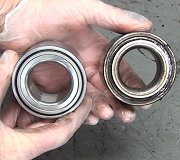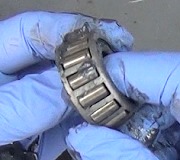What were you asking them to do at the four shops? Did anyone take the car for a test-drive with you?
If you're hearing a buzzing sound like that of an airplane motor, that is characteristic of a noisy wheel bearing. That has nothing to do with play or looseness. In fact, if you do find some play in the bearing, it had been noisy for a real long time leading up to that.
Your car uses a bolt-on bearing assembly on the front. That style commonly doesn't change sound when turning left or right slightly, as in when changing lanes. That is how we tell which side is noisy with the pressed-in bearings Chrysler used to use up to the mid '90s. The noise got worse when you turned away from the noisy bearing because more vehicle weight momentarily transferred onto it. Bolt-on bearings don't act that way very often.
With front-wheel-drive vehicles, the best way I've found to determine which bearing is noisy is to run it in gear on a hoist, then listen next to each one with a stethoscope. One will sound questionable, but then the other one will be seriously louder.
A second method which works with rear-wheel-drive cars is to jack the car up and support is solidly on jack stands, reach over the top of the tire, and lightly wrap your fingertips around part of the coil spring. Slowly rotate the tire with your other hand. If that bearing assembly is noisy, you'll feel the vibrations in the spring.
Be aware it is real common to suspect the wrong bearing by listening to where the sound seems to come from during a test-drive. Noises like that transfer real well and can seem to originate from somewhere else. The good news is bolt-on bearing assemblies do not have to be destroyed to remove them, as is the case with pressed-in bearings. If you replace the wrong one, that old one can be reinstalled on the other side.
Also take a peek at these articles for more information:
https://www.2carpros.com/articles/whirring-sound
https://www.2carpros.com/articles/bearing-hub-replacement
Wednesday, December 30th, 2020 AT 2:17 PM



